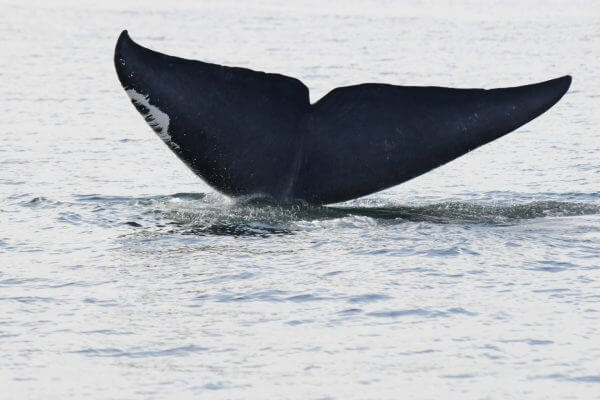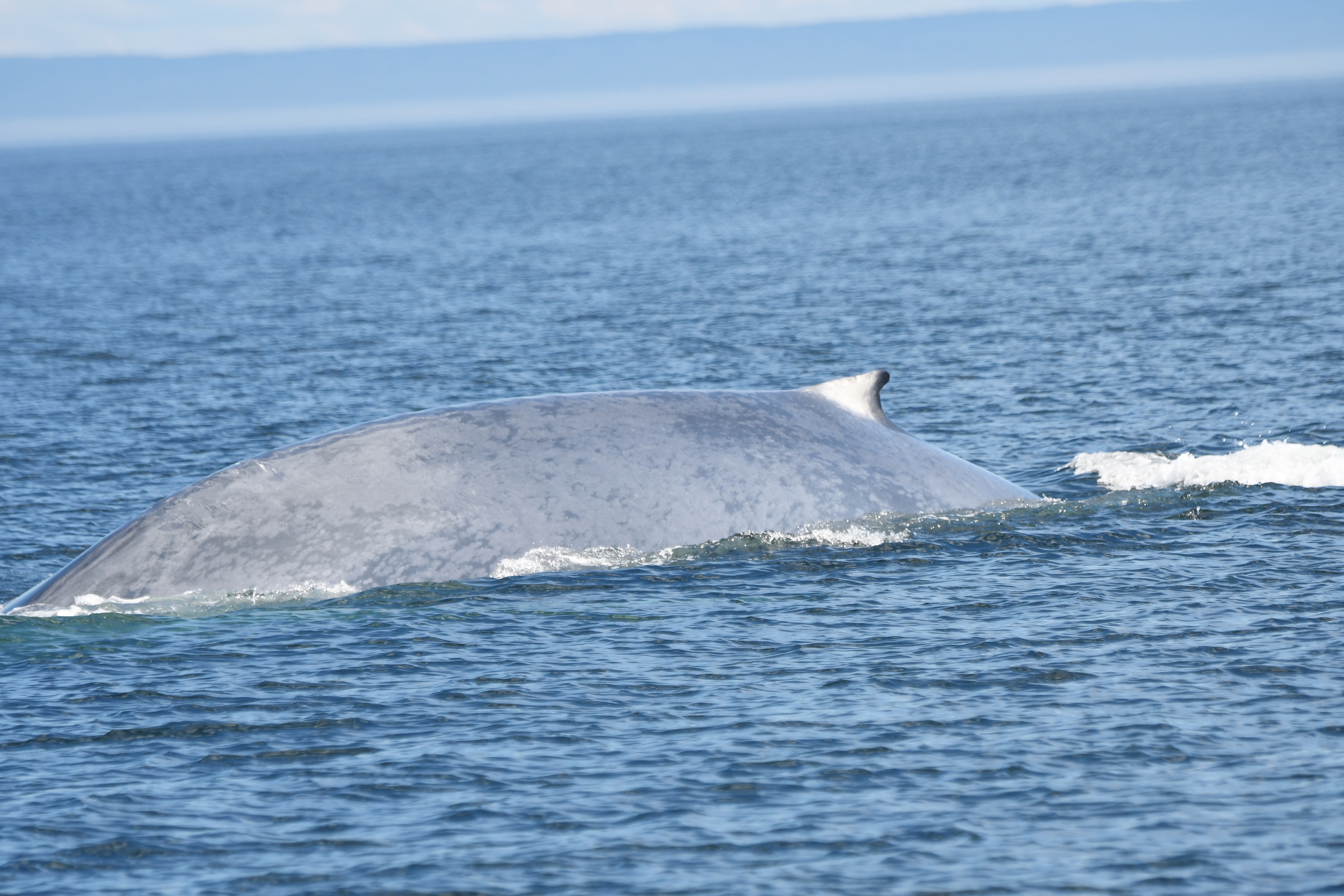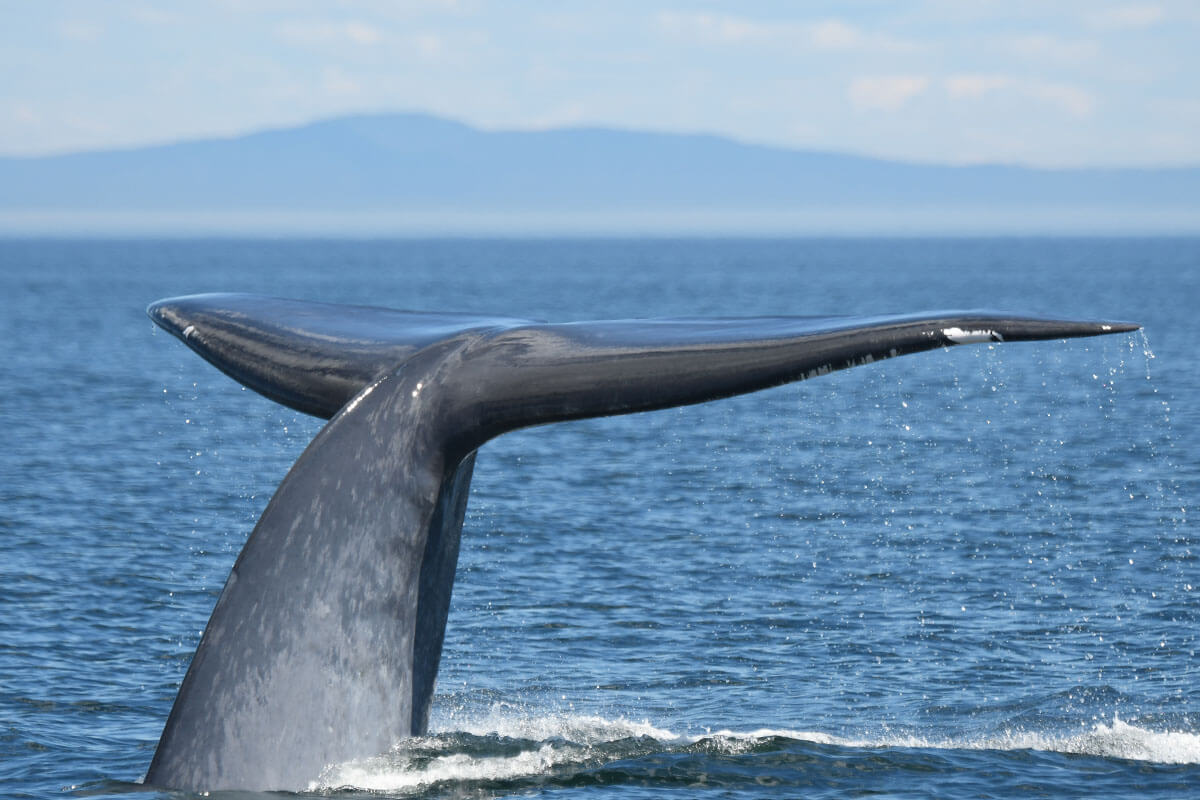Jawbreaker
Blue Whale


-
ID number
B246
-
Sex
female
-
Year of birth
unknown
-
Known Since
1991
Distinctive traits
Jaw-Breaker is one of the 15 to 18% of St. Lawrence blue whales that fluke their tails when they dive. It is in fact when she raises her tail that the white spot located on the edge of the left lobe of the tail, on the side of its belly, can be seen.
This female also has a particularly pale, even shiny dorsal fin.
The pigmentation pattern of her back also confirms her identity.
Observations history in the Estuary
Years in which the animal was not observed Years in which the animal was observed
Latest news from the publications Portrait de baleines
A powerful breath, an interminable grey-blue back, and suddenly, in the sky, a tail composed of two large black palettes adorned with a white spot. This is the Jaw-Breaker effect!
Known since 1991, this female blue whale is one of the stars of the Marine Park. She is a regular visitor to the Estuary – we come across it almost every year – and one of the rare blue whales of the St. Lawrence to raise its tail when she dives. The origin of her name is believed to come from the colouring patterns on its back, which are reminiscent of the hard candys called “jaw-breakers”. But it also seems to fit well with her character. I’ve seen her a few times have a pretty aggressive attitude with males approaching her,” laughs Richard Sears of the Mingan Island Research Station (MICS). The first time, with Biombre [another female blue whale], Jaw-Breaker intimidated a male by blowing and growling. Another year, it was Pulsar, a large male, that she confronted face to face. “Researchers who approached her by boat to perform a biopsy also found her in a difficult mood.
Jaw-Breaker is one of a small handful of blue whales that ventured into the Marine Park this summer. Their visit seems brief, but for a blue whale, the estuary is a very small space, in which they zigzag in search of pockets of krill rich enough for their appetite; these giants can gobble up to 4 tons of it per day!
This week, we introduce you to three blue whales that were recently identified in the Marine Park. The individuals are differentiated by the coloring pattern of their backs. Also, in the St. Lawrence, 15 to 18% of these whales show their tails when they dive. This is the case of Jaw-Breaker: her tail has a white spot that is easy to identify, but pay attention to details, she is not the only one to have a spot at this location.
B093 is one of the oldest males known and identified by the Mingan Islands Research Station (MICS) directed by Richard Sears. Identified several times in the Estuary in 2012, B093 had been observed off Nova Scotia. This year, it was observed by several cruise ships off Les Escoumins and Les Bergeronnes. B197 is also one of the blue whales seen in the Marine Park in recent weeks. As for Jaw-Breaker, this star was finally observed. Two other blue whales have also been identified in the Estuary in recent weeks: B275 and B236.
Blue whales are animals that are often observed alone. However, in the St. Lawrence, they sometimes form more or less stable pairs in early fall. These associations last for more than a day, up to entire weeks. According to MICS biopsy follow-up, they are most often male-female pairs. The formation of pairs could be an early sign of reproduction in these animals that takes place during the winter season. Sometimes a second male joins the pair and all three individuals participate in what is called a rumba; the female swims in front and the two males compete to be closest to her. After a race, which can last several hours, one of the males abandons the race and the other becomes the female’s escort. Do these pairs really result in the reproduction of both individuals? A difficult question to answer in the short term! In 2010, B093 was observed participating in one of these rumbas.
Jawbreaker is a female blue whale well known to the Mingan Island Cetacean Study (MICS). Although she has been observed a number of times in the Estuary, she has never been seen in the Gulf of St. Lawrence. Jawbreaker is recognized by the white spot on the underside of her tail.
However, as she is not the only blue whale to show this trait, we must rely on other criteria such as the pigmentation pattern of her back to confirm her identity. Also, her dorsal fin is light in colour, almost shiny. Only 15-18% of blue whales raise their tails out of the water when they dive. Jawbreaker is one of those individuals. This season, numerous employees of the whale-watching industry and visitors were able to observe this behemoth off the coast of Les Escoumins. Rare and fragile, the blue whale is an endangered species, having been decimated by rampant hunting in the North Atlantic that ended in 1955. In the Marine Park, an observation distance of 400 m must be respected.
MICS has been studying blue whales in the St. Lawrence since 1979. In the Northwest Atlantic, from the northern Davis Strait (between Greenland and Canada) to Bermuda, along the east coast, its researchers have identified over 475 individuals. This year, a big breakthrough in blue whale research was made. An individual photo-ID’d in 1984 in the St. Lawrence was found 30 years later in the Azores and again in the St. Lawrence, in the Gaspé, in 2015. This first ever documented sighting of a blue whale migration on an east-west axis, between the Gulf of St. Lawrence and the eastern part of the North Atlantic puts things into perspective. Measuring 25 m long and travelling hundreds or even thousands of kilometres, these giants live on a completely different scale.
Author: Camille Bégin Marchand
Jawbreaker is one of the blue whales that is particularly fond of the St. Lawrence Estuary: although well known to MICS researchers, she has never been seen in the Gulf. She usually shows her tail when diving, a personality trait that she shares with approximately 15-18% of individuals of her species photographed in the St. Lawrence.
Since the beginning of summer, the GREMM has counted at least four different blue whales in the Marine Park, including Jawbreaker. The latter has been observed from time to time since June 25. Nomadic, blue whales are constantly on the move in search of better patches of krill, small planktonic crustaceans that congregate in immense “clouds” driven by currents, tides, and underwater relief.
Why “Jawbreaker”? It seems that the origin of her nickname has been lost over the years! After being consulted, the MICS team believes that there may be a connection with the hard candy “jawbreakers”, or else with an aggressive behaviour that she might have shown toward other blue whales.
The blue whale is a species at risk; its Northwest Atlantic population is unknown, but it is considered unlikely that it exceeds 250 adults. Disturbance by boats may be detrimental to its feeding. In the Marine Park, these animals enjoy enhanced protection: boats are required to stay at least 400 m away. Outside of the Marine Park, member companies of the Eco-Whale Alliance have undertaken to abide by these same limits to better protect them.
Blue whale Jawbreaker in the Estuary in 2013 © GREMM





